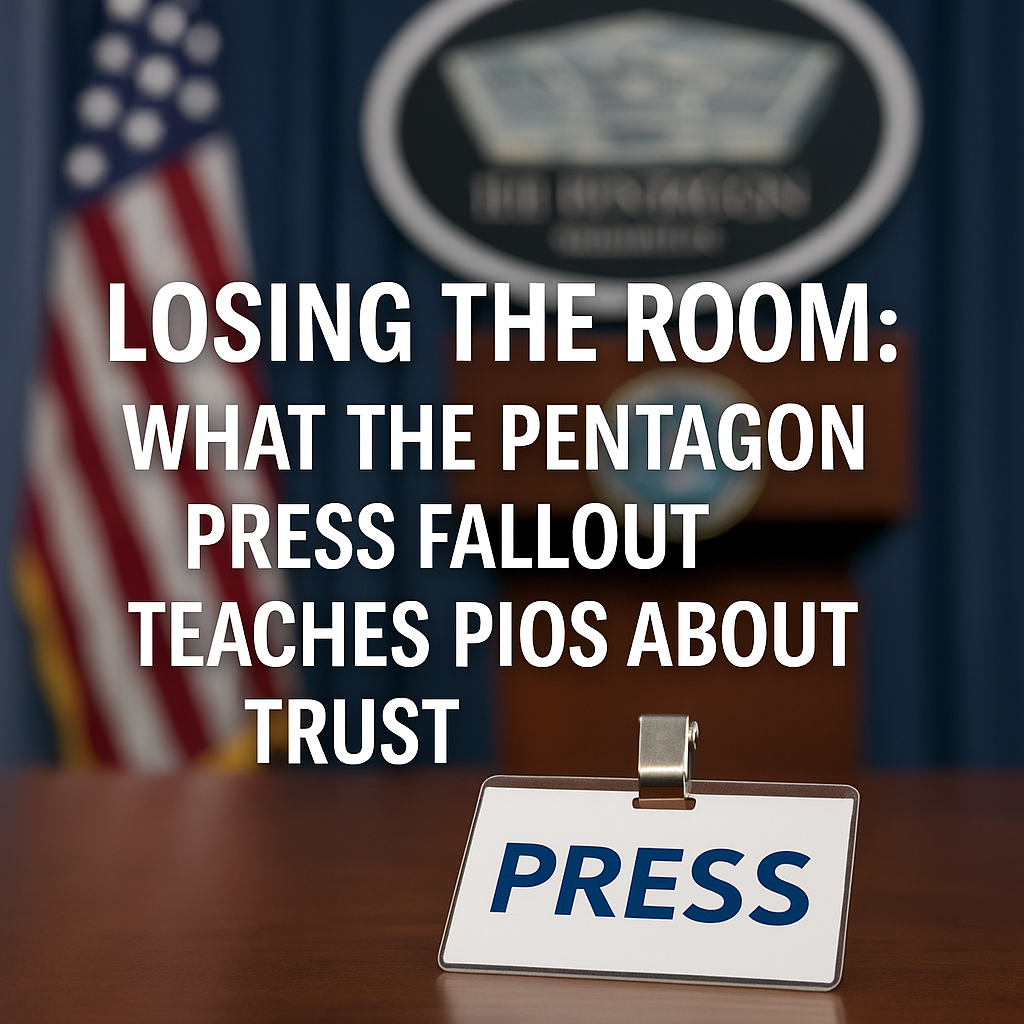In mid-October, something remarkable happened at the Pentagon.
After decades of working alongside defense reporters, nearly every major U.S. news outlet — Reuters, the Associated Press, The New York Times, and The Washington Post among them — packed up their desks, turned in their badges, and walked out of the Pentagon press workspace.
Why? Because of a new media policy that required journalists to sign an access pledge limiting what they could publish and how they could report.
Officials said the change was about consistency and security.
Reporters said it was about control.
Within hours, a long-standing relationship built on trust and routine collapsed into silence.
And while most public information officers will never brief from a Pentagon podium, every communicator can learn something from what happened next.
Change without context looks like punishment.
When Policy Outpaces People
To the Department of Defense, the new rules were a procedural update.
To the journalists affected, it felt like a muzzle.
That disconnect sits at the center of many communications breakdowns.
It doesn’t matter how well-intended a policy is if the people impacted weren’t considered or part of the conversation.
Public information officers face this challenge daily. A new photo rule, a tighter social media policy, or a restriction on ride-alongs may all be justified, but when they’re announced without explanation, they land as distrust. Sometimes, PIOs aren’t the ones making the rules but are stuck enforcing them anyway.
Transparency and Control Must Coexist
Every communicator walks a line between protecting the organization and serving the public.
In public safety and government, that balance can be delicate.
Transparency doesn’t mean sharing everything. It means clearly explaining why you can’t share certain details.
That step often gets missed.
By the time the Pentagon clarified its reasoning, the narrative had already been written:
“Press Censored.” “Access Revoked.” “Media Walk Out.”
Silence is never neutral. When communicators skip the “why,” others will fill in the blanks—and they rarely do it in your favor.
Lesson 1: Relationships Outlast Policies
Press access is not paperwork. It’s a relationship.
For years, defense reporters built credibility with spokespersons and press officers. That mutual respect gave official messages weight, even when stories were uncomfortable.
One poorly communicated policy change erased years of equity overnight.
The same can happen in any local, county, or state agency.
If reporters or partners hear about a rule change from a memo instead of a conversation, you’re not just changing process—you’re changing the relationship.
Before finalizing any communication policy, ask: Who needs to hear this directly from me first?
Lesson 2: The Rollout Is the Real Message
The Pentagon didn’t lose credibility because it updated an access form. It lost credibility because of how the change was introduced.
PIOs understand that timing, tone, and clarity shape perception more than content.
If the people you serve hear about your new rule from someone else first, you’ve already lost control of the story.
A thoughtful rollout—with listening sessions, advance notice, and clear rationale—can prevent a defensive reaction.
Explaining early saves you from apologizing later.
Lesson 3: Trust Is the Only Real Credential
When communicators lose trust, every message becomes suspect.
Facts don’t land. Clarifications don’t matter. The audience assumes there’s something more to the story.
Trust isn’t built by controlling information. It’s built by consistency. That consistency includes telling the truth, explaining decisions, and owning missteps.
PIOs who lead that way are the ones whose calls get answered when the crisis hits.
Lesson 4: Credibility Requires Contact
Once a relationship breaks, a news release won’t fix it.
Rebuilding requires personal outreach—face-to-face meetings, phone calls, and listening before explaining.
Apologies without action don’t rebuild trust; accountability does.
For agencies, that might include:
- Hosting an open media roundtable to discuss access.
- Publishing a plain-language FAQ about new policies.
- Assigning a liaison to collect feedback.
- Reviewing internal approval processes for fairness.
This isn’t weakness. It’s leadership through humility.
A Personal Reflection
When I was a young PIO, several well-meaning leaders told me my job was to “control the narrative” or “manage the message.”
I understand what they meant now, but I also know how misleading that advice was to a young PIO.
Our job as communicators isn’t to control or manage. It’s to tell the truth.
Control is temporary. Credibility lasts.
Over the years, I’ve heard stories of PIOs losing their jobs after bad press about their agency or leadership.
Every time, I ask the same two questions: Was it the truth, and whose fault is that, really?
More often than not, it’s not the communicator’s failure. It’s a misunderstanding of what the communicator’s role truly is.
Public information officers are not miracle workers. We can’t rewrite the facts or erase public reaction. What we can do is deliver accurate, timely, and honest information—even when it’s uncomfortable.
That’s why setting clear expectations with leadership is so important. The PIO’s job isn’t to make the news go away.
It’s to make sure the truth gets heard, clearly and consistently.
That’s how trust is built.
And it’s how good communicators last.
Quick Self-Check for Policy Changes
Before introducing a new rule or procedure, ask:
- Have we clearly explained why this change is necessary?
- Did we invite feedback from those affected?
- Are our internal and external messages consistent?
- Could this be perceived as retaliation or restriction?
- If this went public tomorrow, would we be comfortable with how it looks?
Final Reflection
At its core, public information is about partnership.
When that partnership feels one-sided, people walk away—whether they’re reporters in Washington or residents in your community.
The Pentagon press fallout isn’t just a national headline.
It’s a cautionary tale for every PIO: Trust is built through communication, not control.

